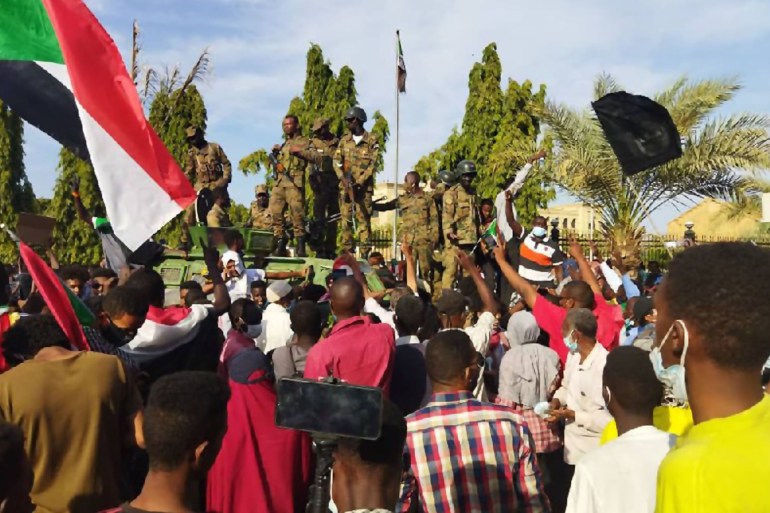KHARTOUM -
Crowds of Sudanese took to the streets on Sunday to denounce the military coup and the political agreement signed between army chief General Abdel Fattah al-Burhan and Prime Minister Abdullah Hamdok, coinciding with the third anniversary of the revolution that overthrew ousted President Omar al-Bashir.
With their departure today, the protesters are trying to exploit the significance of today's date, which is linked to two important events in their history, namely the launch of the popular revolution against the regime of Omar al-Bashir 3 years ago, and when the Sudanese people from within Parliament declared their independence from the yoke of English rule in 1955.
History was also present by calling the name of the “Khartoum Liberation” millionaires for today’s movements that aimed to peacefully overthrow the residents of the presidential palace, as happened in 1885 when Lord Gordon Pasha was overthrown by the Mahdia revolutionaries several months after their siege of Khartoum.
Emotional moments prevailed between the protesters and the army forces near the presidential palace (Sudanese press)
ring penetration
On the eve of the protests, the main bridges connecting the capital's districts (Khartoum, Bahri, Omdurman) were closed, in an attempt by the security services to secure the presidential palace and prevent protesters from reaching it.
However, despite the lack of movement in the morning, the heavy deployment of security forces, and the movement of cars loaded with soldiers in the main streets, in addition to closing and evacuating the center of Khartoum near the presidential palace, the revolutionaries committed themselves to meeting the calls for demonstration, so they gathered massively at the assembly points and distant paths from the center of Khartoum, Then they crawled to their main destination.
After several attempts, the efforts of the protesters in Bahri, Omdurman and East Nile were crowned with success in crossing the barriers and security forces at the Mak Nimr, White Nile, and Manshiyya bridges, respectively.
Security forces used tear gas canisters to disperse the demonstrators (French)
Perhaps the most prominent thing that happened today was the entry of a marine protester into dialogues with the leaders of the security forces responsible for securing the Mak Nimr Bridge, before they crossed the outskirts of Khartoum, during which slogans were raised, such as “peaceful” and “the army is the army of Sudan, the army is not the army of Burhan.”
Al Jazeera Net witnessed one of the protesters' dialogues with a senior officer, during which he confirmed that their movement is in the interest of everyone, including the army and police.
In Omdurman, the communication between the protesters and the army was more cordial, after the protesters bypassed the barbed wire near the buildings of the medical weapon (the most important military hospital in the country) without being subjected to repression, chants glorifying the national army were raised, and some took pictures with the army members, while they hugged Others were the officers and soldiers, some of whom did not hide their affection for the situation, so he broke out in tears.
Several areas witnessed violent clashes between protesters and security forces (Al-Jazeera)
Gas and tears
The determination to reach the presidential palace was the biggest common factor in the capital's processions, while the use of tear gas was the biggest common factor in the security forces' dealings with the protesters.
Khartoum convoys - which managed to reach the streets near the presidential palace early - were exposed to the largest share of tear gas.
Bahri and East Nile protesters succeeded in crossing to Khartoum, but after inhaling quantities of tear gas as part of attempts to disperse them, while Omdurman demonstrators were subjected to severe repression when crossing Khartoum, and they were forced to retreat due to the large-scale use of tear gas by the security forces.
Several injuries occurred in the confrontations, most of them asphyxiated by gas, despite the demonstrators wearing masks and using primitive preventive methods to sniff neem leaves and wash the presence with water mixed with yeast.
Many demonstrators were injured after the security forces resorted to violence to disperse the demonstrators (French)
Cheer and slogan
Sudan's flags were above everyone's heads, and pictures of those killed in the previous demonstrations went hand in hand with the revolutionaries, who chanted, "Our martyrs have not died, we live with the revolutionaries."
But the most prominent slogans today are, "You close the street, you close the bridge... O Burhan Jayink Daghri," in reference to their clear intentions to achieve their goal of reaching the presidential palace despite the closure of bridges and the closure of roads leading to the buildings of the General Command of the Armed Forces.
In their repeated chants today, the chants of "The revolution is a people's revolution.. the authority is the authority of the people.. the military is for the barracks," "the people are stronger, stronger.. apostasy is impossible," along with "O proof, your barracks is first.. there is no militia that governs a state."
No Retreat, No Surrender
During the hit-and-run operations, Al Jazeera Net spoke to the 17-year-old Mahaid Khaled - who arrived from the Kadru area in Bahri - about their intentions for the December 19 move.
Mohid said that they aim to reach their destination as predetermined, and "then wait for the directions of the leaders of the resistance committees. If they say they withdrew, we withdrew, and if they say we will enter a sit-in in front of the palace, we will definitely do so."
As for Reem Mamoun - a university student who was among a wide range of women participating in the procession (demonstration) today - she said that the December 19 procession "gives the revolutionaries priority and credibility in implementing their revolutionary promises, and thus their pledges to return Sudan to the path of democracy and prosperity."

